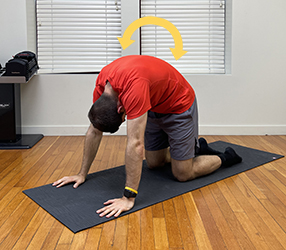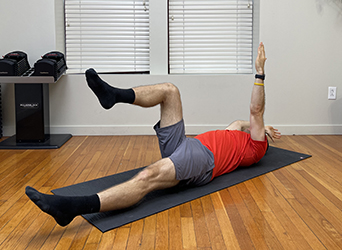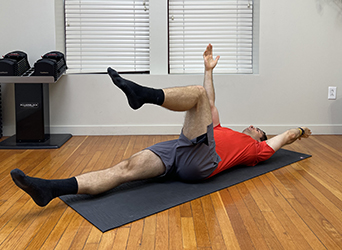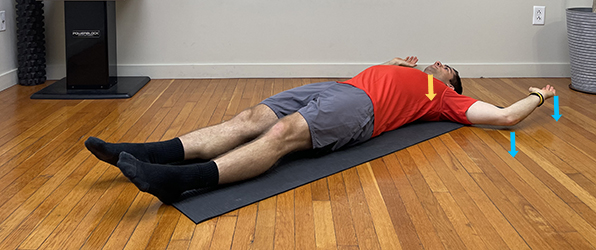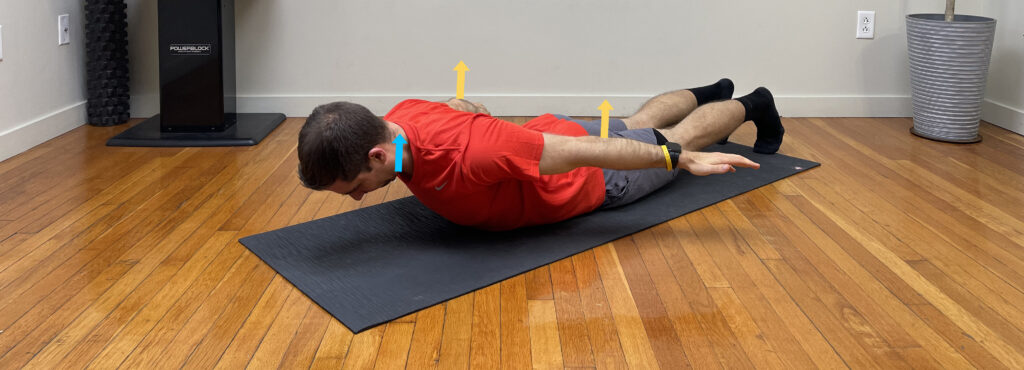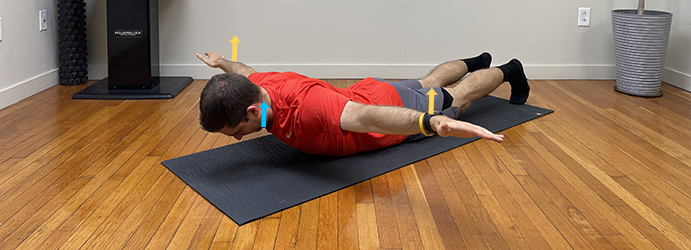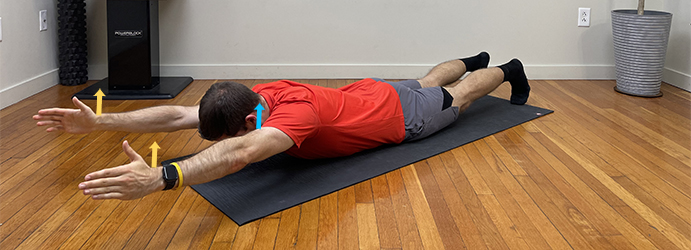As work and entertainment increasingly become digital, we’re spending more time sitting than ever before. We’re sitting at work, sitting while in transit, and sitting when we’re home. We’re always sitting! And as our body spends more time in a single position, it’ll adapt to those demands. Just as hockey players’ hips tend to tilt forward and rotate out to meet the demands of skating and handling a puck on the ice, office workers tend to experience the same thing with their hips constantly being flexed while sitting and their shoulders/neck rounded while looking down at a laptop screen or phone. This repeated act often leads to tightening of certain muscles along with weakening of opposing muscles. This then not only makes it hard to maintain good posture in the first place, but can also lead to chronic pain, acute injury, and a lack of overall mobility. So today, I’m going to briefly overview the most common postural issues we see with desk workers and I’m going to provide you with a daily 10–15-minute posture routine you can perform to correct and prevent these issues. Let’s get into it!
Most Common Postural Issues for Desk Workers
There are three primary areas where the body tends to compensate when we spend too much time sitting: the feet and ankles, the hips and lower back, and the neck and shoulders. What tends to happen is the feet start to lose their range of motion with dorsiflexion (pulling the toe to your shin), especially in women who wear heels. The hips start to tilt anteriorly (to the front) which can cause an arched lower back. And the shoulders generally round forward with the head and neck protruding forward. These three conditions are called pronation distortion syndrome, lower crossed syndrome, and upper crossed syndrome. And while I’m oversimplifying these conditions, they’re the most common issues seen within desk workers. With these conditions, the muscles that are contracted most often while sitting become tight and short while the opposing muscles become loose and lengthened. This then leads to the body preferring bad posture because the muscle length and tension relationships have been altered. Below, you can see what happens to our posture when these conditions appear.

Pronation Distortion Syndrome 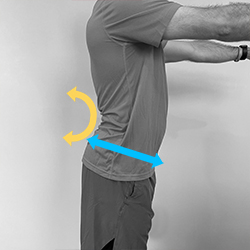
Lower Crossed Syndrome 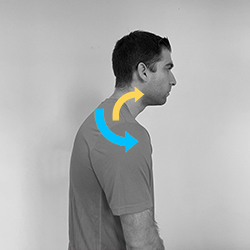
Upper Crossed Syndrome
The Corrective Posture Routine
So, the fix for these issues is relatively straight forward. First, we want to loosen the tight muscles through stretches. And second, we want to strengthen the weak muscles through exercises. So, today’s corrective posture routine is going to involve a variety of light stretches and exercises that work these exact muscles that we see the most common issues with for desk workers. And if you’re interested in me detailing each of these syndromes individually with tests you can perform to see if you have them, let me know in the comments below and I can create future posts on them. Otherwise, let’s get into the routine!
Half Kneeling Dorsiflexion Stretch (6 Reps Each)
First, we’re going to start off in a half-kneeling position with each leg at 90-degree angles. Then we’re going to lean forward onto that front leg, decreasing the angle between our front foot and shin. We’ll hold this position for about 2 seconds and return to the upright position. We’ll do six repetitions of this stretch on each leg which will help us regain dorsiflexion that’s commonly lost sitting at a desk all day or from wearing high heeled shoes often.
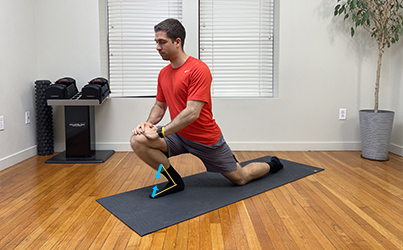
Calf Stretch (30 Second Hold)
Next, we’ll get into a push-up position and pull our hips up to the ceiling. Then we’ll try to press our heels down into the floor stretching out the calves. These muscles can restrict ankle mobility as well when they’re tight. We’ll hold this position for thirty seconds.
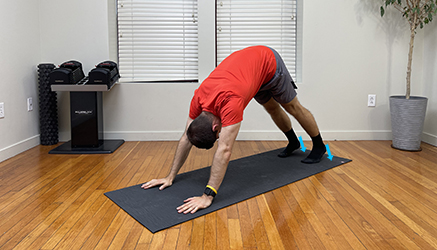
Plantar Fascia Stretch (30 Second Hold)
Next, we’ll get into a kneeling position and extend our toes underneath our feet onto the floor. This is going to stretch out the plantar fascia, or ligaments on the bottom of the foot. We can lean back onto our feet to apply more pressure to the stretch. None of these stretches should be painful, but we should be pushing our available range of motion as that is what will increase our mobility.
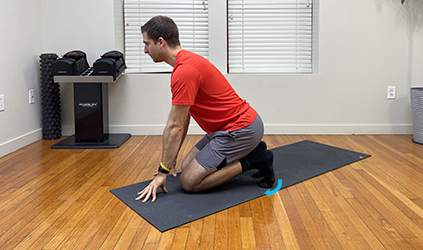
Isometric Dorsiflexion Holds (30 Seconds Each)
Now that we’ve lengthened most of the tight muscles that can restrict ankle dorsiflexion, we want to strengthen the weak anterior tibialis which is the muscle that generates dorsiflexion. For this, we’ll want to sit on our butt with our legs extended straight out in front of us. Then we’ll place the top of our left foot on the top of our right foot. Now we’ll attempt to hinge the right foot to the shin while using the left foot to prevent the motion. This is called an isometric hold. We’re attempting to flex the right foot, but our left foot is preventing it. We’ll hold this attempted movement for 30 seconds and then switch feet.
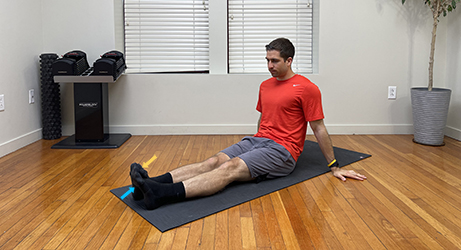
Half Kneeling Side Bends (30 Seconds Each)
Now we’ll get back into the half-kneeling position where each of our legs are at a 90-degree angle. We’ll first start with the right leg up front, and we’ll then tuck the butt underneath us, causing the hips to tilt posteriorly and stretch out the hip flexors. These muscles are constantly contracted when we sit, and this is a great stretch to loosen them up. We’ll then take our left arm up to the ceiling and reach it over our head to the right side of the room. This will stretch out the psoas and other tight muscles in the hips. We’ll hold this stretch for thirty seconds and then switch sides.
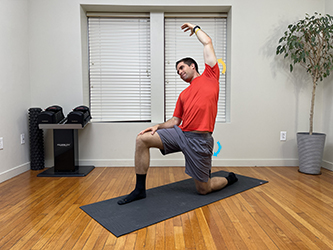
Cat-Cows (6 Repetition)
Next, we want to get on all fours to stretch out the other tight muscles that can affect our hips. Once on all four, we want to breath in and arch our back down to floor as much as possible. We’ll then slowly breath in and arch our back in the opposite direction to the ceiling. We’ll perform this movement for six repetitions which will loosen up our lower and mid back muscles.
Glute Bridge (10 Repetitions)
Now that the tight muscles which can cause hip issues are loosened up, we want to strengthen the weak and underactive muscles that level out the hips. First, we’ll start by laying on our back with our hands at our sides. We’ll then flex our knees and bring both our heels to our butt. Once in position, we’ll shoot our hips up to the ceiling into a bridge position, hold it for a second, and then bring them back down to the floor. We’ll perform 10 repetitions of this exercise to strengthen the glutes and hamstrings.
Dead Bugs (10 Repetitions)
Next, we want to perform some core work to strengthen the underactive and weak abs. Let’s lay down on our back with arms extended overhead. We’ll raise the left arm straight to the ceiling and bend the right leg to a 90-degree angle where the knee is now shooting up towards the ceiling. We’ll then go into the opposite position by bringing our left arm directly overhead and our right arm fully extended to the ceiling, while straightening that right leg out and bending that left leg. This is considered one repetition and we’ll do ten of them.
Chest Opener and Overhead Reach (30 Seconds Each)
Next, we’ll start to work on the rounded shoulders and protruded neck. Let’s lay on our back with our arms in a cactus position at 90-degree angles. Make sure to keep the lower back in contact with the floor. And we’ll try to let gravity pull our elbows and wrists to the floor. We’ll hold that for 30 seconds to stretch out the muscles in our chest. Next, we’ll extend the arms straight overhead while keeping the low back on the floor, and again try to bring our elbows and wrists to the floor. We’ll again hold that for 30 seconds to stretch out the muscles in our back (the lats).
Snow Angels (10 Repetitions)
After stretching out the tight muscles which can round the shoulders and protrude the neck, we want to build up the muscles that can hold them in proper alignment. We’ll lay on our stomach with our toes planted on the floor and arms at our side. We’ll raise our chest and arms off the floor while keeping our chin tucked in tightly. We’ll then bring both our arms straight overhead as if we were making a snow angel. We’ll bring the arms back down to the side and perform 10 repetitions all while keeping the chin tucked in tightly and feet on the floor. We’re really focusing on bringing the shoulder and arms back as far as possible and focusing less on bringing the chest off the floor as high as possible. This will focus the exercise on our mid and upper back muscles which are the weak ones.
Final Thoughts
This 15-minute corrective posture routine isn’t going to completely fix 23 hours and 45 minutes of bad posture throughout the day. You’ll need to incorporate more movement, regular exercise, and an ergonomic desk setup to help with that. But what this corrective routine can do is loosen muscles that are constantly flexed and tight from sitting all day like your chest, hip flexors, and calves. It can also strengthen the opposing muscles which are under activate and loose like your upper back, glutes, and anterior tibialis. And over time, this routine will slowly straighten out your feet, level out your hips, and pull back your shoulders and neck allowing you to not only get into a proper posture easier, but maintain it longer. Personally, I’ve been following this routine every day for the past three months, and I’ve seen results! My posture has improved, and my back and heels have never felt better. So, if you’re spending a lot of time sitting like I do then I recommend you do this routine at least daily. Not only will it help correct common postural issues you may already have, but it’ll prevent ones from occurring in the future. And to me, that sounds like a healthier and happier life.

Good Foot/Ankle Alignment 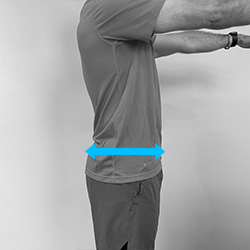
Good Hip/Back Alignment 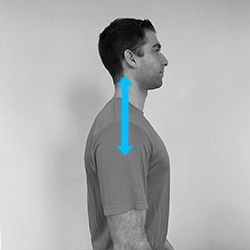
Good Shoulder/Neck Alignment
Looking for the top three things I’ve read, watched, and listened to this week? Check out my free health kit and weekly newsletter.
Watch a YouTube Video Summarizing the Post

Hey, I am Brandon Zerbe
Welcome to myHealthSciences! My goal has always been to increase quality-of-life with healthy habits that are sustainable, efficient, and effective. I do this by covering topics like Fitness, Nutrition, Sleep, Cognition, Finance and Minimalism. You can read more about me here.
Sources:


